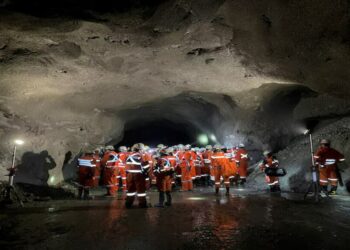If you enjoy the feeling of being trapped, maybe you’ll enjoy The 33. The unavoidable consequence of making a movie in which the main characters are confined to a small, dark space for much of the film is that there’s little forward movement. It’s a narrative dependent on absence: the absence of sunlight, conversation, and action.
As the posters and trailers won’t let you forget, The 33 is based on a true story, and the story itself is a good one: In 2010, 33 miners were essentially buried in Chile’s 121-year-old San Jose mine notorious for its long history of safety violations. The men were trapped in an unstable mountain 2,300 feet underground, in 90-degree heat, with enough food and water to last just three days. Against almost all logic, every man survived for 69 days, while the entire world watched. Again: it’s a good story. But not every good story needs to be made into a movie.
It’s probably impossible to create a film that effectively recreates the fear, hopelessness, resignation, and sheer boredom that comes with being buried alive — and if it were possible, no one would see it, because no one wants to spend their Friday night experiencing the act of waiting to die slowly. The other hurdle all “true story” movies must overcome is that the audience knows the ending before the movie even starts; any suspense has been minimized by history. In the case of the Chilean miners, no one actually died (an established fact for anyone who glanced at the news in the fall of 2010). From the start, the movie’s happy ending hangs in the distance, and it’s difficult to watch without feeling impatient it takes so long to get there.
WE ALREADY KNOW THE END
The 33’s director Patricia Riggen probably understood this impossibility, and so she spends the beginning of the movie milking the audience’s knowledge of the event with heavy-handed foreshadowing.
The day before the accident, seasoned miner Mario Sepúlveda (Antonio Banderas) asks his boss Don Lucho (Lou Diamond Phillips) if he can work the next day, despite it being his day off. A young miner with a baby on the way turns down a safe job working in a store because it pays much less. And an old miner with almost 50 years of experience talks about how happy he is to be retiring in two weeks.
Once the men are inside the mine, a single falling cigarette is evidence that the mountain is big, and a broken mirror signals that the mountain is unstable.
The movie’s small pleasures are mostly found in the performances of Banderas and Diamond Phillips, who are both complex and sometimes dislikable in the way you might grow to dislike someone after spending two months trapped in a mine with them. Banderas’ Sepúlveda is chatty and brash, but consistently level-headed and idealistic. And Phillips’ caring, but pessimistic leader is a quiet force throughout the movie. But the actors are limited by overly dramatic dialogue (“the mountain’s heart is broken”) that, critically, is all delivered in English. One would think Hollywood could get over its fear of subtitles, especially in light of the success of multilingual shows like Narcos, but The 33 feels gratingly retro by comparison.
the-33
There are small moments of levity throughout The 33, but the humor only serves to displace any lingering sense of seriousness the movie may have had. Half the comedy is centered around one miner’s wife cattily fighting with his mistress. At one point, the mistress pulls the wife’s pants down in a distressingly slapstick fashion. When the miners eat what they believe what will be their final meal, they imagine their wives and lovers, all boobs and sequins, serving them giant hamburgers and empanadas. The hallucination goes on for a frustratingly long time, making sure the audience doesn’t miss the hint that the miners are both hungry and horny. The rest of the comedic moments come either in the form of smirky lines from Banderas or fart jokes. (I honestly don’t know how there are fart jokes in this movie, but, mind-bogglingly, there are).
The 33 is two hours long, and it feels like it. An hour and a half into the movie, the rescue team finally makes contact with the miners. It’s an ecstatic moment because all of the miners are, astonishingly (at least to the people above ground), alive. Hugs are passed around, and the end of the movie seems imminent. Then the lead engineer says, “We’ve still got to get them out.” This was probably meant to illuminate how long of a process the whole thing was, but it felt like a taunt.
THIS ACTUALLY HAPPENED, WHICH MAKES THE MOVIE’S PROBLEMS WORSE
All of the problems with The 33 are made even more uncomfortable by the fact that the men in the Copiapó mining accident actually exist. Their experience, maybe the worst of their lives, was created by a geographic and economic stranglehold, and exacerbated by political ineptitude and callousness. The Hollywood version of that experience might make you think, once the miners are safely rescued, Hey, that whole being stuck in a mine thing didn’t seem that bad. They all lived, and now they’re famous! The 33’s neat package trivializes everything unknowable about what the men (none of whom received any compensation following the accident) really went through.
Despite its many flaws, The 33 knows its job is to tell what is basically a miracle story of heroism and survival. And when the time comes — family reunions, tears, friendship — it can manipulate human experience for a gut punch. The 33 is a bad movie, but you can’t say it doesn’t have a heart.








